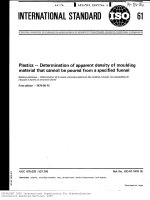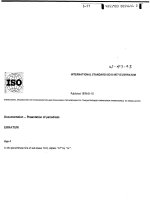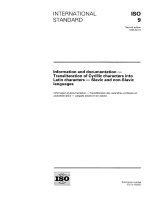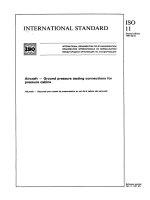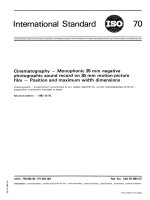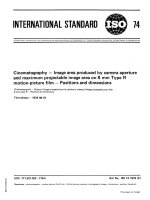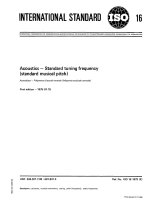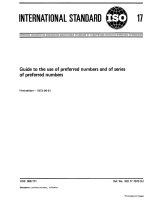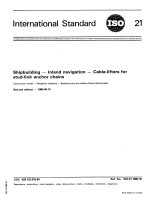Tiêu chuẩn iso 00022 1991 scan
Bạn đang xem bản rút gọn của tài liệu. Xem và tải ngay bản đầy đủ của tài liệu tại đây (264.37 KB, 8 trang )
IS0
INTERNATIONAL
22
STANDARD
Second edition
1991-12-15
Belt drives corresponding
tolerances
Flat transmission
belts and
pulleys - Dimensions and
Transmissions par courroies - Courroies plates de transmission
poulies correspondantes
- Dimensions et foltkances
et
Reference number
IS0 22:1991(E)
IS0 22:1991(E)
Foreword
IS0 (the International
Organization
for Standardization)
is a worldwide
federation of national standards bodies (IS0 member bodies). The work
of preparing International Standards is normally carried out through IS0
technical committees,
Each member body interested
in a subject for
which a technical committee has been established
has the right to be
represented
on that committee.
International
organizations,
governmental and non-governmental,
in liaison with ISO, also take part in the
work. IS0 collaborates
closely with the International
Electrotechnical
Commission (IEC) on all matters of electrotechnical
standardization.
Drafl International
Standards adopted by the technical committees are
circulated to the member bodies for voting. Publication
as an International Standard requires approval by at least 75% of the member
bodies casting a vote.
International
Standard IS0 22 was prepared by Technical Committee
ISO/TC 41, Pulleys and belts (including veebelfs), Sub-Committee
SC 1,
Veebelts and grooved pulleys.
This
second
edition
cancels
and
replaces
the
first
edition
(IS0 22:1975), together with IS0 63:1975, IS0 99:1975 and IS0 100:1984,
of which it constitutes a technical revision.
Annexes
6
IS0
A and B of this International
Standard
are for information
only.
1991
All rlghts reserved. No part of this publication may be reproduced or utlllzed In any form
or by any means, electronic or mechanical, including photocopying and microfilm, without
permlsslon In wrltlng from the publlsher.
International Organization for Standardization
Case Postale 56 l CH-1211 Genkve 20 l Switzerland
Prlnted In Switzerland
II
INTERNATIONAL
IS0 22:1991(E)
STANDARD
Belt drives - Flat transmission
belts and corresponding
pulleys - Dimensions and tolerances
1
Scope
This International
Standard specifies the principal
dimensions of flat transmission
belts and of the corresponding pulleys.
from the R 20 series of preferred
numbers in accordance with IS0 3. The other values are chosen
from the R 40 series.
Annexes A and B give, respectively,
recommended
crowns of the pulleys and the ordinary
recommended correspondance
between the widths of
belts and the widths of the pulleys used.
Table 1 - Lengths of belts
Dlmenslons in milllmetres
Preferential
2
Normative
reference
3
3.1
numbers
1 000
1 120
1250
1400
1600
1800
2 000
2 240
2 500
2 800
3 150
3 550
4000
4500
5000
- Series of preferred
Belts
series
1
530
600
670
750
850
950
1 060
1 180
1 320
1 500
1 700
1 900
1) Should the range of lengths given in table1 be
considered insufficient, it may be completed:
Length
The lengths specified
normal fitting tension.
Secondary
500
560
630
710
800
900
The following standard contains provisions which,
through reference in this text, constitute provisions
of this International
Standard. At the time of publication, the edition indicated was valid. All standards
are subject to revision, and parties to agreements
based on this International
Standard are encouraged to investigate the possibility of applying the
most recent edition of the standard indicated below.
Members of IEC and IS0 maintain registers of currently valid International Standards.
IS0 3:1973, Preferred
numbers.
series!)
are the inside
lengths
The manufacturer
shall take account of
ence between the length under normal
sion and the length without tension. This
depends on the nature of the belt and its
manufacture.
under
the differfitting tendifference
method of
The belt lengths particularly
recommended
(preferential series) are given in table 1 and are selected
-
outside the limits, with other terms
series of preferred numbers:
from the R 20
-
exceptionally,
between two consecutive
lengths
with terms from the R 40 series [from 2 000 mm).
NOTE 1 If required for any technical reason, it is permissible to cut a length of belting and braid it together at
the ends to form a belt of any length suitable for a particular application.
1
IS0 22:1991 (E)
3.2
Width
4
The belt widths and their tolerances are given in table2. The widths are selected from the R 10 series
of numbers in accordance with IS0 3 for values less
than or equal to 63 mm and from the R 20 series for
higher values.
Table 2 - Widths of belts
Dimensions In milllmetres
W id th
nom.
to1.
16
20
25
32
40
50
63
12
71
I%
112
125
The widths, h, of pulleys and their tolerances
given in table3. The widths are selected from
R 10 series of preferred numbers in accordance
IS0 3 for values less than or equal to 63 mm,
from the R 20 series for higher values.
+4
Dimensions In mlllimetres
b
nom.
20
25
32
40
50
63
71
to1.
+I
III 1,5
160
180
200
224
+2
250
280
f5
are
the
with
and
Table 3 - Widths of pulleys
125
140
140
280
315
355
400
450
500
Width
80
90
100
112
80
160
180
200
224
250
1
4.1
Pulleys
315
355
400
450
500
560
f3
IS0 22:1991(E)
4.2
Diameter
Table 4 - Diameters of pulleys
The diameter of a pulley for a flat transmission
belt
is the diameter, D, measured in the plane of symmetry of its rim (see figure A.l).
Dimensions in milllmetreIS
The diameters, D, of pulleys and their tolerances are
given in table 4. The diameters are selected from the
R 20 series of preferred numbers in accordance with
IS0 3.
nom.
tol.
45
50
f 03
56
63
zk ‘A8
125
140
+ 116
160
180
200
+2
224
250
* 2,5
280
315
355
* 3,2
400
450
500
14
I
t
I
t
560
630
710
800
900
1 000
+5
+ 693
+------
1 120
1 250
1 400
+_8
21 000
600
800
* 10
3
IS0 22:1991(E)
Annex A
(informative)
Crown
A.1
A.2.1
Shape of crown
It is recommended
should be a regular,
that the shape of the profile
symmetrical
curve.
A symmetrical
profile with a flat central
ceptable provided that:
a) the flat part is tangential
Pulley diameters
For this series of pulley diameters, the crown height
varies only with the diameter of the pulley and is
unrelated to the width of the rim.
part is ac-
Table A.1 - Crown height values
Dimensions In mlllimetres
to the curve;
Pulley
Crown
h
nom.
40
125
160
200
250
315
400
560
Crown height values
The height, h, of the crown of a pulley for a flat
transmission
belt is given for information
in either
table A.1 or table A.2 and varies with the diameter
D of the pulley (and, for the larger diameters, with
the width b of the rim). The crown height may vary
according to the materials used for belt construction
(the belt manufacturer
should be consulted).
diameter
D
b) its width is not more than 40 % of the width of the
pulley.
A.2
40 mm s D < 710 mm
d
<
<
<
<
<
<
d
D <
D d
D <
D <
D <
D <
D <
D <
112
140
093
0,4
095
180
224
280
355
500
096
03
1
1
192
710
A.2.2 Pulley diameters
800 mm < II G 2 000 mm
For this series of pulley diameters, the crown height
varies with both the diameter of the pulley and the
width.
Table A.2 - Crown height values
Dimensions in mllllmetres
Pulley
diameter
D
nom.
b
800 Q D < 1000
112O
Figure A.1 - Crown of pulleys for flat transmission
belts
132
195
13
13
2
2,5
IS0 22:1991(E)
Annex 6
(informative)
Ordinary
recommended
correspondance
between
belt widths
and pulley
widths
Table B.l - Ordinary recommended correspondance
Dimensions In milllmetres
Belt width
Pulley
width
16
20
25
32
40
50
63
20
25
32
40
50
63
71
71
80
90
100
112
125
80
90
100
112
125
140
140
160
180
200
224
250
160
180
200
224
250
280
280
315
355
400
450
500
315
355
400
450
500
560
NOTE - If, for any technical reason, it is preferable to use a wider pulley for a particular belt, as frequently
the narrower belts, such a pulley may be chosen from the series of pulleys given in table3.
occurs with
IS0 22:1991(E)
UDC 621.65.052.41:621.65.051
Descriptors:
belt drives,
Price based on 5 oases
belts, power transmission belts,
pulleys,
dimenslons,
dimensional tolerances.
